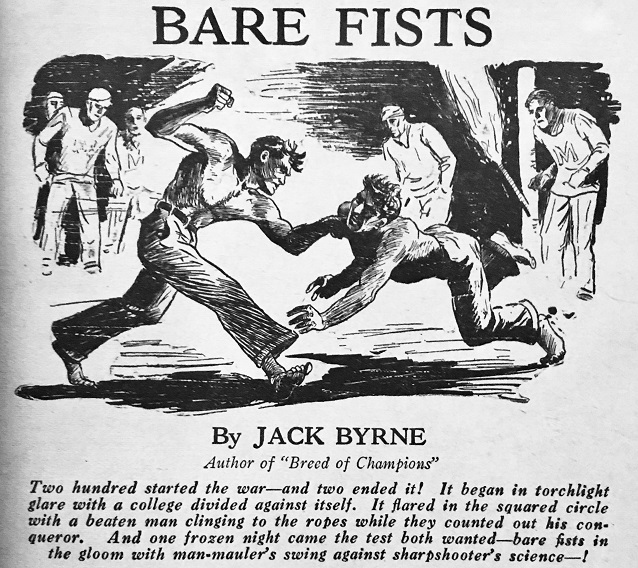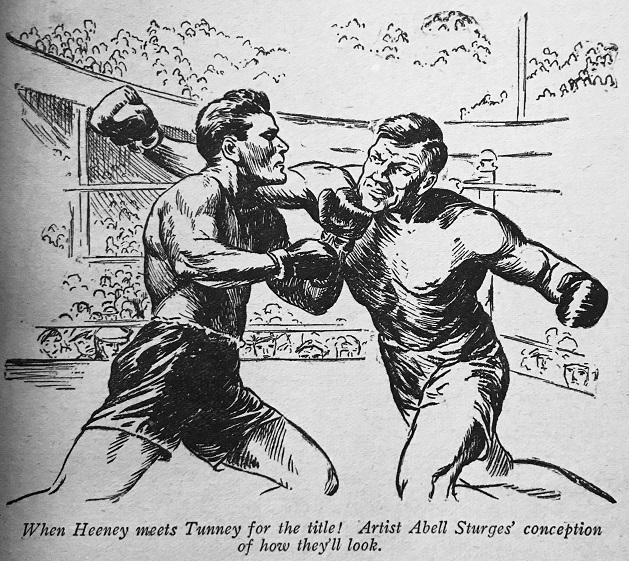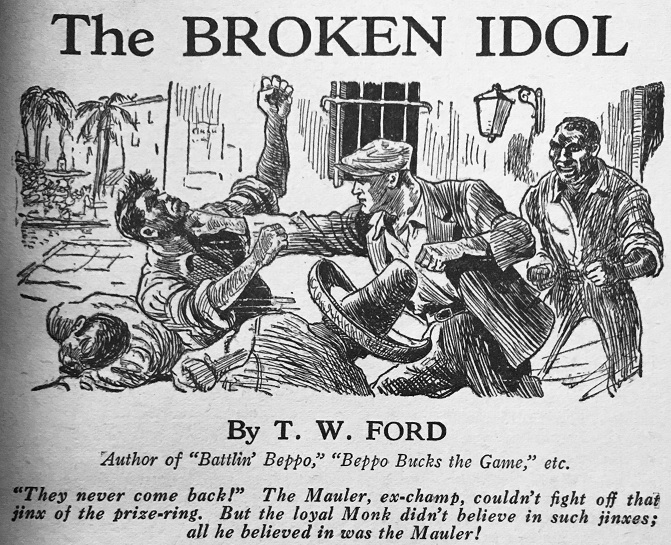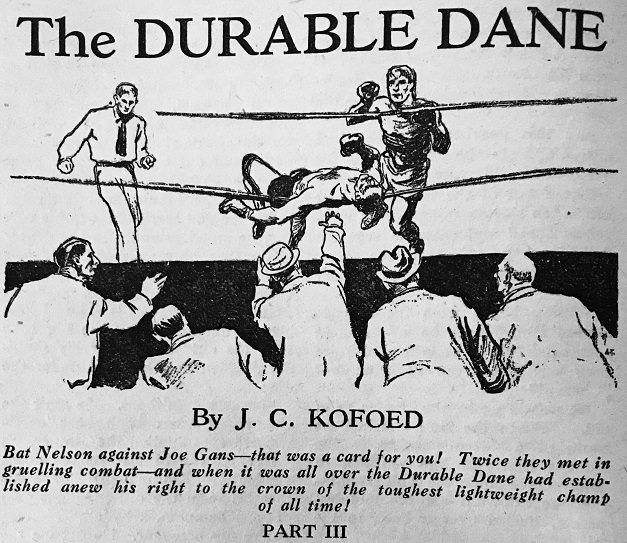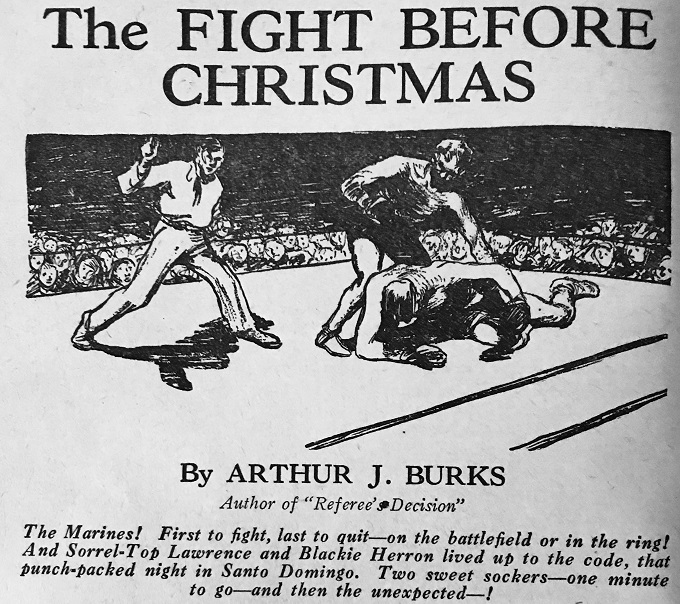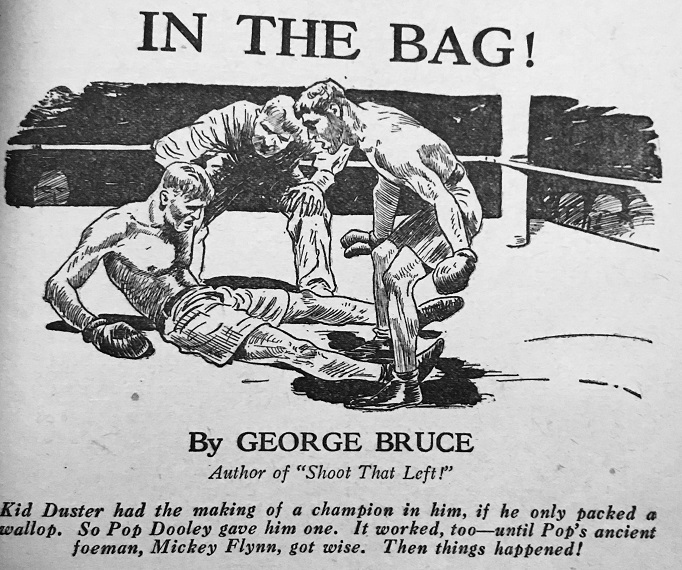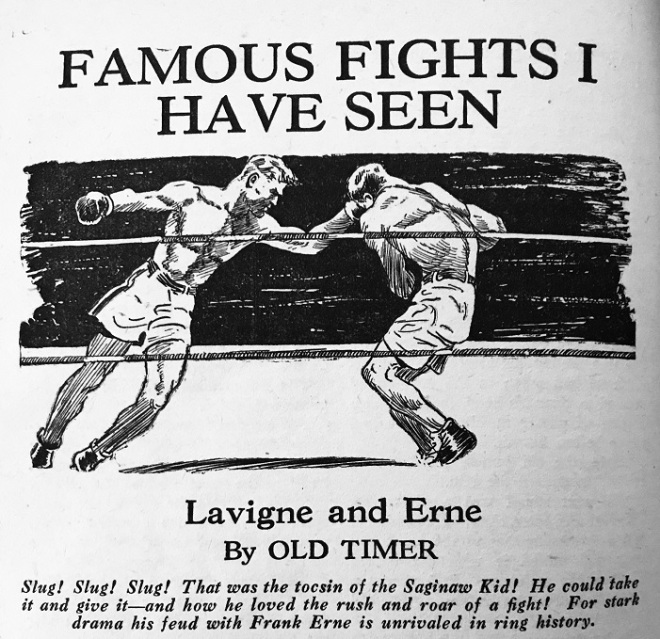Fight Stories debuted in June 1928 as part of the Fiction House line of pulps and ran for 47 issues until its untimely demise May 1932. It would be resuscitated Spring 1936 and run for 59 additional issues until Spring 1952. Featured here is the 3rd issue, dated August 1928, sporting cover art by Abell Sturges. Story head illustrations credited to Frank McAleer and Allan Thomas per the contents page. I will be including below all of those illustrated story heads.
Jack Byrne‘s novelette Bare Fists is too damn good to provide an abridged synopsis. Jack debuted in the pulps the prior year and scorched out ten rapid-fire yarns, most for Fiction House’s Action Stories. Two cousins with an interest in the same girl duke it out in high school. “King” Carroll comes from money and moves on to college. The lady of interest likewise goes to the same co-ed school. Bill Carroll, son of a farming family, is without funds to pursue higher education. He remains behind, works and saves up money attend the same college. Entering as a freshman, he watches from afar a fight between a freshman and a sophomore. Why? An annual competition, freshman must face off against the sophomore defender to win the right not to wear certain clothes and hats or be hazed, etc. They always lose. The winner wins by beating their opponent and dragging them across the opposing line. “King” is chosen for the third round.
The freshman’s challenger is unavailable, but the newly arrived Bill Carroll has already shown as a physical specimen. Dragging him forward against his will he is met with much surprise and hatred by his cousin. For the first time since that high school brawl, Bill greets his cousin. Nobody realizes they are related. At least, not then. “King” delivers a brutal knockout punch to Bill’s jaw. Delirious, on the ground, “King” rolls and drags him strugglingly toward that line. Bill revives in time, a mere foot away, and the pair duke it out. “King” likely wins at he falls unconscious upon Bill, knocking him backwards toward the line, but a freshman catches Bill and the entire field erupts into a free-for-all. Skipping tons of various scraps over the days and weeks, the pair are called before the dean and forced with expulsion or behave as gentlemen. “King” smartly says so long as they are campus, yes. Bill picks up the key words and concurs. The dean is smarter than these two dopes. He’s brought to the campus the boxing training legend “Spider” McCauley. His job is to train the pair to box. Moreover, a print sheet is circulated at the school enlisting other boys to join. These two however have no choice. “King” has been exiled from football by the faculty overnight and Bill is enlisted against his will. Either may refuse and accept a permanent car-ride home. Succeeding pages involve the pair getting in shape and Spider training all the boys. “King” has brute strength and finesse, whereas Bill shows quality but sloppy inside the mitts. Spider mentions to his assistant that Bill has a killer bare-fist punch that would have done well in the pre-mitt days, but his cousin would slay him in the ring. Bill is clearly superior within a challenger’s reach, but kept at bay, he’s done. Then again…his piledrivers spell doom if they connect. And a knockout counts! Arranging “King” to watch Bill after weeks of private training, Bill loses two rounds against a conditioned boxer then knockouts out the bloke in the third round. “King” isn’t impressed, but Spider repeats in less than 3 minutes, a well-conditioned boxer just went down to a work-in-progress. “King” hasn’t kept up his training, but smugly retorts to his classmates that his cousin won’t “get inside” of his reach. It angers Bill that he trains so hard while his cousin scrapes by in studies, scarcely works out, eats and smokes as he will, and fools around off campus. Bill even keeps away from girls, including high school sweetheart Mary Carson, who he passes at times on campus and sees with “King” too. She’s infuriated he won’t make time to spend time with her, yet notes “King” freely does so. He writes her a letter discussing the team eliminations bout Thanksgiving night. If he survives, he’d like to take her to the dance. She writes back an acceptance. That long-awaited night arrives, and eventually after several bouts, “King” and Bill Carroll are the last two standing and now it’s their turn. Bill is headed to the locker room to prepare when he overhears Spider and his assistant discussing Bill and “King” casually. Spider affirms that Bill will win against the lazy “King” who would easily win if he had trained. Bill is nothing by a second-rater. Stunned, Bill eases into the locker room and sits, stunned. Bill goes into the ring and toys with “King,” taking long punches from “King” to his face readily but while exposed, steps in and delivers kidney punches, gut busters, etc. Beating his cousin mercilessly, every time they clinch, Bill explains to “King” what he’s planning to do him. The crowd thinks “King” will win. Mary Carson is cheering on “King” too, while feeling bad that Bill is getting pummeled. “King” has clearly landed many more punches to Bill that vice versa, but Spider can see “King” is soft. Even Bill comments with each clench things like “your belly is soft,” and “that’s for drinking.” His cousin is torched, through, weak-kneed, yet won’t fall because Bill walks in and clinches to support him. After destroying his opponent, he inexplicably throws the match, telling “King” he plans to make sure “King” wins, that he has a future in the ring if trained properly. He’s willing to lose!!! But he has to do so with science, cleverly. Delivering a brutal fist to “King” that latter falls back scarcely supported by the ropes. The crowd is shocked. They thought he was solid the whole time. Not it is evident he is done, all a façade. Nobody hears it, but Bill whispers as he closes, telling “King” to swing. And he does, with every last willpower he can muster. The mitt connects and Bill goes down and enjoys the numerical count with each passing second. He won, oh, he won. And he’s going to make sure “King” keeps training, whether he likes it or not. After the match, Spider storms into the locker room, livid with rage. He immediately recognized a thrown match and demanded to know what Bill was doing. Bill replies that “King” will be the heavyweight champion and, getting up, leaves behind a confused Spider. Mary Carson is waiting for him to take her to the dance, but he says no, he lost. Mary knows better, and informs him he won. She knows! He rejects the dance. He hasn’t time for such things. He must remain focused, must train “King.” The pair walk side by side out into the night. Next day, Bill waits for “King.” That latter goes to town, skipping his training. Bill is there. A shadow. Calls him to task. And knocks “King” publicly flat out. He’s dragged back to campus. “King” won’t go to sleep at the proper time? Bill short-circuits the dorm’s wires! “King” is caught smoking off-campus; Bill slaps it out of his mouth and they fight, and Bill eventually drops his weakened cousin. “King” can’t stand up to Bill’s bare fists! His only chance is the ring. A week of this and “King” relents. He promises to train, wins the championships or do down trying. And however it ends, he’s coming back, back to a final show-down with Bill and his bare fists! “King” wins all his fights but each time loses his sanity. In his final fight, he is clearly crushed and insane, trying to strip of his gloves and muttering bare fists all he sees now is Bill Carroll in the rings. He mauls his opponent, going in for in-fighting jabs Bill Carroll style now, murderous blows. Bill back home reads of the wins but doesn’t know that “King” has lost his mind, is muttering bare fists at the bouts… “King” is suffering from blood lust. For 3 days Bill waits for his cousin at the train depot but he never arrives. He picks up Mary and takes her to the Homecoming dance. In the gym, he finds “King” there in a rich man’s tuxedo that makes Bill’s looks cheap. “King” invites Bill to step outside into the snow. He accepts. Mary is mortified. Following the pair outside, begging them not to fight, they strip down and strike. But this fight has no ring-rules, so “King” has the edge. He’s trained. He’s a killer. And he’s not fighting Bill. He’s killing him. Bill goes down, down, down, and “King” keeps grating out Bare Fists! Mary shrieks in fright, seeing not “King” but Death. That shriek pierces Bill’s foggy mind and snaps him awake. And from the ground, with a murderous piledriver coming down to meet his upraised delirious face, Bill comes alive. The conclusion has “King” knocked out and bloodied, Bill climbing unsteadily to his feet, bloodied, and Mary calling him a brute to his face for what he has done. Bill turns on his feet, swaying, and walks away, leaving her cradling the unconscious head of his cousin. He’s more bewildered and confused when she approaches him, beats him about the chest, the inexplicably hugs and kisses him. Was she up until that point confused as to which Carroll she loved? She would never in life tell him, but she had fallen in love with him many years ago, when they were 7 years old and he of the two Carroll’s rescued her cat. Women!
Fight Stories also ran boxing articles on current and past canvas sluggers such as this one. New Zealand-born boxer has an article called Tom Heeney’s Own Story, as told to William Morris. He famously came to America and battled Gene Tunney at Yankee Stadium 26 July 1928. Heeney arrived in America a year prior, had 9 bouts; 6 wins, 1 loss, 2 draws. His first loss and first draw in America incidentally were to the same man: Paulino Uzcudun Eizmendi. The second draw was to famed boxing legend Jack Sharkey. Heeney would ultimately chalk up his second loss, to Tunney, but this magazine debuted before that boxing bout took place. Abell Sturgess supplied a half-page illustration depicting what he thinks the first clash between Heeney and Tunney would look like.
Like Jack Byrne above, T. W. Ford debuted in 1927 with Action Stories magazine. Unlike Byrne, Ford was extremely prolific. Both lasted as long as the pulps did, until the mid-1950s. The natural progression to mass market paperbacks was a forgone conclusion. It’s uncanny that Ford doesn’t have his own Wiki page. James Reasoner thankfully had something to say about T. W. Ford on his Rough Edges blog, back in 2018. The Broken Idol features a wonderful action story-head and is spectacularly full of blood-and-thunder excitement. The Mauler is mauled by a fleet-of-foot boxer who in his better-trained days shouldn’t have stood a chance. But his trainer (Shifty) set him up for a fall. Battered, bloody, bruised, and a wholesale wreck, the ex-champ abandons the ring forever. However, his faithful “second,” a black man called Monk, convinces him he is still His Champ, and funds a fight. He loses. Shattered, he wholly gives up and catches the first ship outbound. Monk shadows him, following him from boat, to boat, to boat, to seashore dives, etc. People slice him, punch him, kick him, etc.; he absorbs all of it and slinks away. But Monk sticks to him like velcro, firmly believing that his broken idol will one day return. And that day arrives Down Under, at a bar. The local boxing hero stalks in with his crew and demands The Mauler and his man to vacate their table. The Mauler is drunk and slow to react, but Monk has simply personally had enough being pushed around. He steps forward and takes a stab at the local champ. The punch is ineffective. He knocks Monk about. Something inside The Mauler cracks, especially when they refer to his second as a nigger. Monk boasts that his man is The Mauler, ex-champion, etc. The local isn’t impressed, but when one of the fellows present attests that he recognizes the drunk sure-enough as The Mauler, a fight is arranged. And remarkably, The Mauler agrees! Monk trains The Mauler on the beach and strives to get him back into fighting shape. Two years of atrophy. Monk shaves the man clean and whips out the champ’s old cape, faded, salt stained. The Mauler puts it on and steps into the ring. Four rounds in and the Mauler knows he is defeated but this local pug. The Monk pulls a sly fast-one, confesses he lied, the pug is the local lightweight champion, and shows him a local newspaper announcing the fight. The Mauler stares at it, looks across the canvas at the local champ. He’s bloodied, weary, clearly not holding up. The Mauler’s pride surges. He can take this man. And he does. He flies across the canvas and delivers fast, powerful punches from his past, with energy not seen before. The man falls, and Monk confesses to another lie. That man was not a champ at all. He had cut-and-pasted the man’s name onto the newspaper from another fight! The Mauler doesn’t care. Informs the slight black man that Monk is now his manager and to go find him a champion to fight! It’s time to get back into shape and regain his lost title.
This issue launches the third installment of the four-part serial by Jack Kofoed entitled The Durable Dane, a true story telling of Bat Nelson against Joe Gans, along with a bunch of other glove-slingers.
The Fight Before Christmas by Arthur J. Burks reads like a true account tale. It opens by inserting himself (Burks) as not only the narrator, but also noting that he also boxed once, as did other top-notch writers such as Jack London and Thomason. This tale involves two fighters in South America and the gentlemanly spirit they brought to the conclusion of their match: one not willing to knock out his opponent when delirious on the ropes; the other returns the favor by throwing in the towel when his opponent is unable to rise, so he pushes the ref aside and picks up his man to save him the loss. So, who won!?!?!?!
George Bruce is an interesting person, and this site has some wonderful scrapbook letters from Bruce himself, well worth the visit. In the Bag! features Kid Duster with all the right moves but he simply does not have a “knock-out punch.” Pop Dooley is up against another Irish rival trainer and decides to pull a fast-one on him. While taping Kid Duster’s hands and applying talcum, he switches the powder for plaster of Paris, a fast-hardening gypsum. The “Kid” complains that his hands feel tight and can’t move, but Pop sends him unaware into the ring. The “Kid” dusts his opponent quickly, delivering shockingly hammer-blows that knock him flat. They win, but a local stoolie saw the plaster in use and turns informant to the competition. Irate, they plan a rematch, and apply the same plaster to their man. Pop doesn’t know this and also applies plaster to “Kid,” but before he does, the stoolie with deft fingers reaches into the boxer’s bag and swaps it out with real talcum powder. The “Kid” takes a brutal, bloody, rib-caving beating, but after a good rest from the bell suddenly finds his “punch,” despite having no assistance. He dances in and delivers long-reaching blows repeatedly to his opponent, dancing out of range of those plaster-fists, and wears down his opponent to a final knockout.
Famous Fights I Have Seen: Lavigne and Erne is a regular column feature bylined by the anonymous “Old Timer.” This article really dials it back in time. “Kid” Lavigne was born in 1869 and attained worldwide fame in 1896, becoming the first Lightweight Champion. He lost his title three years later to Frank Erne in a 20-round battle.
Fools for Luck is by Miles Overholt; he wore many hats over the course of his life; Miles was a dramatic film critic in Portland and relocated to Los Angeles; he also sold a slew of stories for the pulpwoods. A man walks under a ladder and shatters a large mirror on the way through, then survives being run down by a hearse only to rise from the dirty road wielding a purse with a large roll of bills inside. Nobody claims the cash but boxer Joe Edwards is impressed. He fires his manager and informs this complete stranger that anyone who can survive so much bad luck and come up with cash is his manager. See, Joe Edwards is superstitious. Very much so, so that now he has a man that seems to have faced bad luck and certain death to come out immaculate and now the lucky manager of Edwards. What does he know about managing a boxer? Nothing; that doesn’t matter. Our lucky manager discovers Edwards is a complete nobody. No ranked boxer will take him on. Not worth their time. But he has an old friend from school days who manages a ranked boxer and finally convinces him to meet his man in the ring. If Edwards wins, he will suddenly be known. Edwards begins losing the fight when he discovers his opponent (Biff Kelly) has a four-leaf clover tattooed on his arm. He can’t beat that sort of luck, can he? Our protagonist agrees until he spots a gent watching the bout with one leg up on a chair. Under that shoe? A horseshoe. Running up to said gent, he asks the man to place both legs up in plain sight for his boxer. Edwards sees the pair of horseshoes in his favor and pulverizes the sole clover. And our manager sees a way to continue winning decisions based on Edwards’ crazy superstitious beliefs. He makes the mistake of signing Edwards to duke it out with “One-Round” Mulligan, all muscle and speed Irish. He destroys Edwards throughout and with the 11th Round complete, is delirious. Our manager realizes that if we hit the 13th Round, Edwards is dead. He’s scared to death of 13, and so he reminds Edwards of this fact. It works. Edwards is so petrified of Unlucky 13 that he comes to life and goes toe-to-toe with Mulligan. Mulligan kisses the canvas. So Edwards takes on another canvas-killer and drops him too, on the way towards taking on Feenzie. Their certain of victory until the lucky manager discovers a flaw: this will be Edwards’ 13th fight! There’s only one recourse: divert Edwards into another fight! So he arranges unranked black boxer Big Benson to take a stab and Benson plays along with the rigged fight, enraging Edwards to step into the ring. After taking a good beating, our manager yells at him that he is now in his 13th fight! It works. He freaks, Big Benson drops him, and accepts his bribe funds. Next day, Edwards is happy and ready to fight Feenzie. With 13 out of the way, there are no more bad luck figures to figure in!
Zach the Giant Killer by Theodore Roscoe initially seems more at home in Physical Culture magazine or the pulp Sea Stories. Theodore Roscoe has a short Wiki entry, too. He died in 1992, so I wonder if any pulpsters ever met the man. Zachary is second mate and suffering the indignations heaped upon him at sea by two heavies throwing their weight around while their canvas manager accompanies them on their sea voyage. The two are slated to duke it out in the ring but the world doesn’t know that they are chummy, nor managed by the same man. Also onboard is a trim wisp of a beauty in a blue dress who has never uttered a single word to Zachary. Torturing the second mate beyond reason, only the fight manager sees that Zachary is seething beyond his boiling point. The only thing keeping him in check is his position aboard the floundering boat. Measuring a mere 5 ft 4 inches, they loudly call him a “shrimp” and a “cheap sailor” and “half pint” and other derogatory remarks. Finally the girl makes her appearance and infers he isn’t much of a man if he takes all the verbal abuse they dish out. When he asks what’s he to do about it, she remarks he ought do what any other man would. He doesn’t. He keeps his tongue in check. Then comes a hurricane that wrecks the vessel. She takes on water, and lists. Everyone on board is placed into lifeboats and he suffers worse by being partnered with the mouthy boxers, manager, and the girl and her father. Four days later, he’s ashore and contracted to go back out to sea. He rather not, tired of his sea voyages, when to his amazed eyes approaches the duo he despises most in life along with their manager. Striking a firm pose before the pair, immovable, he intelligently verbally destroys the pair then in a series of quick, powerfully scientific strikes, K.O.s one boxer and the other gets into the wharf-side fight of the century. The manager attempts to interfere but is knocked aside; the wharf rats soon hear of the fight and encircle the pair. Zachary eventually knocks his man out, too, and collapses against a warehouse wall, bloodied, and spitting out a tooth. Into his field of vision comes the girl; shocked and awed she approaches him and he utters that he did just as she instructed. Well, he also does just what any other man would do, and teach her a lesson…he marries her and they have four children. He also abandons his second mate job and takes to the ring, clobbering towering behemoths. And so Zach the Giant Killer is born. An excellent blood and thunder yarn by a man that was the son of missionaries!
Keeping Fit by Jimmy De Forest was another regular feature of Fight Stories instructing men on how to stay fit for the fight, training, eating, etc. Were these articles really authored by the famed boxer / trapeze artist? Possibly. Jimmy is perhaps today best known (if at all) for managing Jack Dempsey. Bizarrely, there isn’t the typical Wikipedia entry for this guy. The articles ceased to appear in Fight Stories in 1932 when the magazine folded and Jimmy died later that same year, dirt poor. I don’t know if he wrote the articles or licensed his name to be used.
The Neutral Corner was a column supplemented by letters from readers and occasionally authors contributing to Fight Stories. They often discussed fights they saw, submitted corrections to prior issues, noted which stories they enjoyed the most, etc. Among the numerous fans writing in is pulpster Olin Lyman, an ex-sports editor and amateur boxer (for fun) himself. The consensus of readers largely agree that from the debut issue, George Bruce’s “Shoot that Left!” was the best story.
And as a bonus feature, I’ll supply this page near the end of the magazine, noting other magazines they publish and highlighting key authors and stories.

